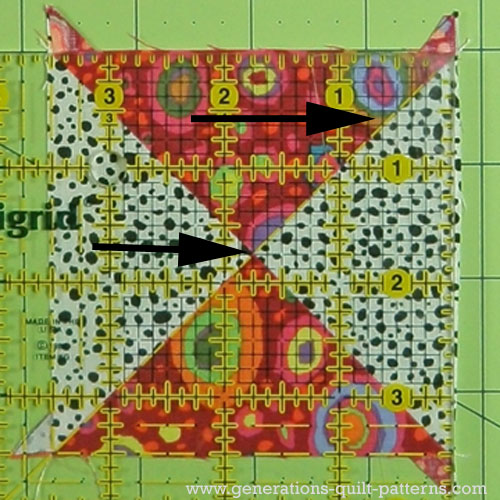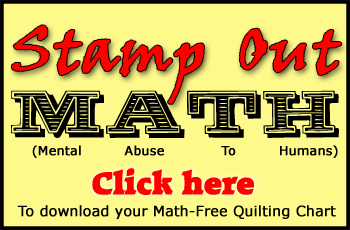- Home
- Beginner Quilt Blocks
- Quarter Square Triangles
Learn to Make Quarter Square Triangles
Technique #2: Quick Pieced/Sandwich Method
This post contains affiliate links, for which I receive compensation.
Quarter square triangles are one of the basic building blocks in quilting.
And just a smidge more difficult than half square triangles.
In fact, the first step in this technique is to make a half square triangle.
This method is sometimes called the 'sandwich method'; sometimes it's called 'quick piecing'.
Either way, it's fast and reliable!

Pros:
- Never sew on a cut bias edge
- No special tools to buy, though you may need a square ruler in Step 8 for trimming the block to size
- No paper to remove
- Makes 2 at a time, most patterns need quarter square triangles in multiples of 2
Cons:
- Using this method with 3 or 4 fabrics creates mirror-image blocks, most patterns require identical blocks
- The blocks must be marked
The newest quilt fabrics to tickle your fancy...
Click the images below to see the full collection. We share any commercial and/or free patterns that showcase them, too. (For inspiration, of course!)
The Technique
Determine the finished size of the QST unit...
...and add 1-1/4" to it for seam allowances.
Cut one square this size from two different fabrics.
It's that easy.
The Formula
The finished block size plus 1-1/4".
For our example, we want to stitch a 3" finished QST unit. For our first 5 steps, we're making half square triangles just like we did in Half Square Triangles: Technique #1.
Step 1
Calculate the size fabric squares to cut
3" (finished size of unit) + 1-1/4" (for seam allowances) = 4-1/4" (size to cut fabric squares)
Step 2
Cut one 4-1/4" square from each of two fabrics. Draw a diagonal line from corner to corner on one of the patches.

Step 3
Sew an accurate 1/4" away from the drawn line on both sides.
I like to start my stitching on a 'spider' or 'anchor cloth' first. There is less chance of my sewing machine 'eating' the corner of the patch.

Step 4
Cut along the drawn diagonal line.

Step 5
Press the units flat to set the seam.

Helpful Hint
Position the closed patch with the darker fabric on top.
Then when you open it to press, you automatically press the seam allowance to the dark side.
Press the patch open with the seam allowance towards the darker fabric.

At this point, you have created two half square triangles.

Step 6
On the back of one of the units, with a ruler and pencil draw a diagonal line from corner to corner. This line bisects the seam.

With RST, alternating dark and light fabrics, align the outside edges of
the two units and nest the seam allowances together.
If you feel more
comfortable, use a pin or two to hold the patches together.
Stitch 1/4" away from both sides of the drawn line.
 The seam allowance on top is pointing towards the needle. There is less chance it will get 'flipped' during sewing.
The seam allowance on top is pointing towards the needle. There is less chance it will get 'flipped' during sewing.Steps 7&8
Cut the unit in two on the drawn line. Press again as in Step 5.
If you chose the 'Exact Size' from our Cutting Chart, the only thing you'll be trimming here are the dog ears.
For this example, I did cut my squares using the 'Exact Size' and you can see that my sewing was a bit off today. The block is a wee bit bigger than it should be.
To trim a unit down to size or confirm it is the correct size after the sewing's all done find the Center or Midpoint of the unit with your square ruler. For our 3" finished (3-1/2" unfinished) block, this number is 1-3/4" or...
The unfinished size ÷ 2
Find the intersection of this number on your square ruler.
Place this point directly over the center of your block, aligning the 45° line with one of the seam lines. (See the arrows in the photo below.)

Trim the excess fabric from two sides.
Turn your block to so that the other two edges are in position to be cut. Align the midpoint (1-3/4") on the ruler with the center of the patch. The cut edged should line up with the unfinished block size (3-1/2") markings on your ruler.
Trim the final two edges.
 The two trimmed sides are now under the ruler
The two trimmed sides are now under the rulerYour quarter square triangles are finished.

Download and print cutting charts
To download and print your 'Quarter Square Triangle Rotary Cutting Chart', just click on the 'Stamp Out Math' logo to the right.
Wherever
you see this logo on this site there's a new chart to print for your reference
notebook.
You need to have Adobe installed on your computer to do this. (Click here for the most recent version of Adobe--this link opens in a new window.)







